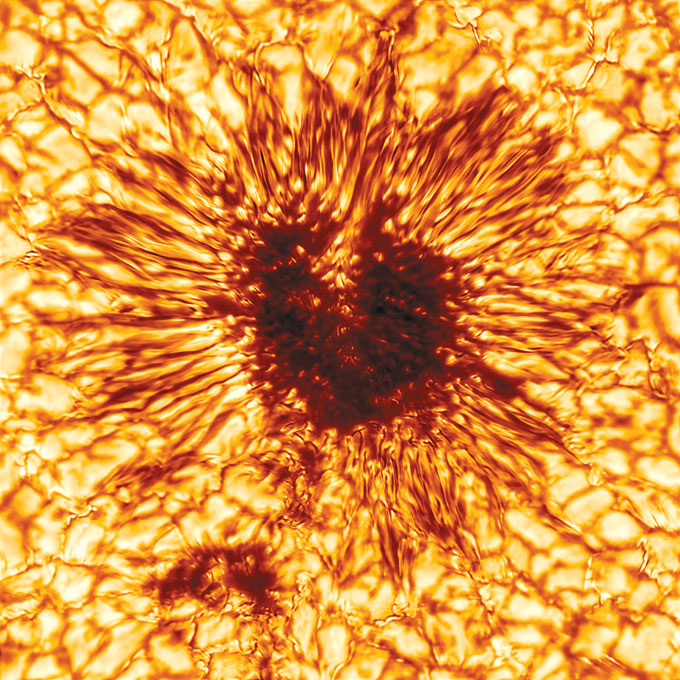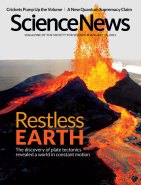Readers react to the history of plate tectonics, pandas rolling in poop and more
- More than 2 years ago
Shaking up memories
A post–World War II data boom clinched the unifying theory of plate tectonics after decades of debate over whether Earth’s crust was static or mobile, Carolyn Gramling reported in “Shaking up Earth” (SN: 1/16/21, p. 16).
The story reminded some readers about their experiences around the time of the theory’s birth in the 1960s.
Reader Jane Smiley recounted her experience as a student at Harvard University when plate tectonics was being hotly debated. “My professor was Bernhard Kummel … and we had to use his textbook. I was present at a great symposium on plate tectonics, which was attended by geologists from around the world,” Smiley wrote. “There was a cacophony of vociferous arguments flying back and forth about the validity of plate tectonics. Everyone brought their papers using the overhead projector and some of the Europeans discussed Alfred Wegener’s theory [of continental drift], and they got rebuffed by my professor as well as many others in the field,” she wrote. “I was a ‘drifter,’ but I sat quietly while I listened attentively to the arguments. Professor Kummel was not a drifter and when I had to write papers in his class, I had to swallow my beliefs and write what he wanted to hear. It was a very exciting time to be a student there, and I learned to be an independent thinker in many disciplines.”
Reader Mark Wilson recalled attending a lecture in the late 1960s by geophysicist J. Tuzo Wilson who, Gramling reported, compared the impact of the theory of plate tectonics to that of Einstein’s general theory of relativity. The geophysicist shared “his ideas concerning oceanic hot spot island chains such as Hawaii, and what he called transform faults in the ocean floor,” Wilson wrote. “I also worked for the summer of 1968 aboard a Canadian geophysical research ship on the Mid-Atlantic Ridge, surveying the ocean floor stripes of magnetism and gravity measurements, and conducting seismic tests. I ended up becoming a vertebrate paleontologist and biology professor, but always enjoy science writing that combines geology and biology.”
Wilson wrote that he plans to incorporate Gramling’s story in his teaching. “I have enjoyed [her] science writing for several years and have gathered a number of her articles as resources for my students. They are always clearly written, interesting and thought-provoking,” he wrote. “When I next teach my course, the students will have several writing assignments, and one of them will be to produce a science news essay, hopefully interesting, like Gramling’s work.”
What stinks?
Wild giant pandas that coat themselves in horse manure may be seeking out two chemical compounds in the poop that inhibit a cold-sensing protein, Jonathan Lambert reported in “Pandas may roll in poop to stay warm” (SN: 1/16/21, p. 14).
“Fresh horse dung has a signature aroma to it, very tangy,” reader Pat Rapp wrote. “Are those two volatiles … responsible for that edge to the aroma?” he asked. Rapp also wondered if the compounds are present in the dung of other species such as donkeys and zebras. “If memory serves, donkey dung doesn’t broadcast itself with anything like the strength of horse dung.”
The compounds might contribute to horse manure’s strong odor, says Lambert, but he doesn’t think they are solely responsible for the stench. “The researchers are currently investigating whether these compounds are present in the dung of similar species,” he says.
Sun spotting
Earth’s largest solar telescope has captured the sharpest image ever of a sunspot (below), Christopher Crockett reported in “A sunspot’s moment in the spotlight” (SN: 1/16/21, p. 32). While many people on Facebook commented on the sunspot’s resemblance to the Eye of Sauron from The Lord of the Rings, reader DeWayne Williams mused about connections between the macroscopic and microscopic worlds. “You ever think the universe looks like what you might see under a microscope,” he wrote.

Correction
“Suspended education” (SN: 1/16/21, p. 24) reported that a study looking at a color-blind approach to reducing the discipline gap between white and Black students showed that the gap grew from a threefold difference to more than fivefold. This is incorrect. The gap grew to almost fivefold.
